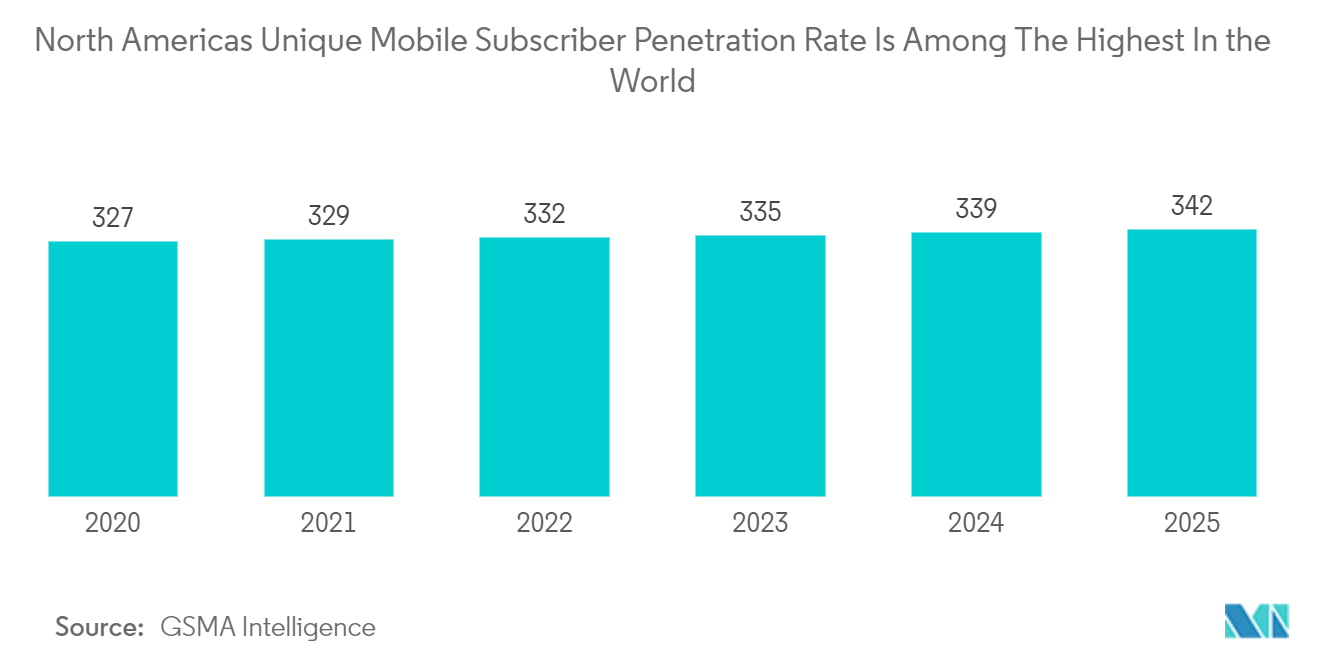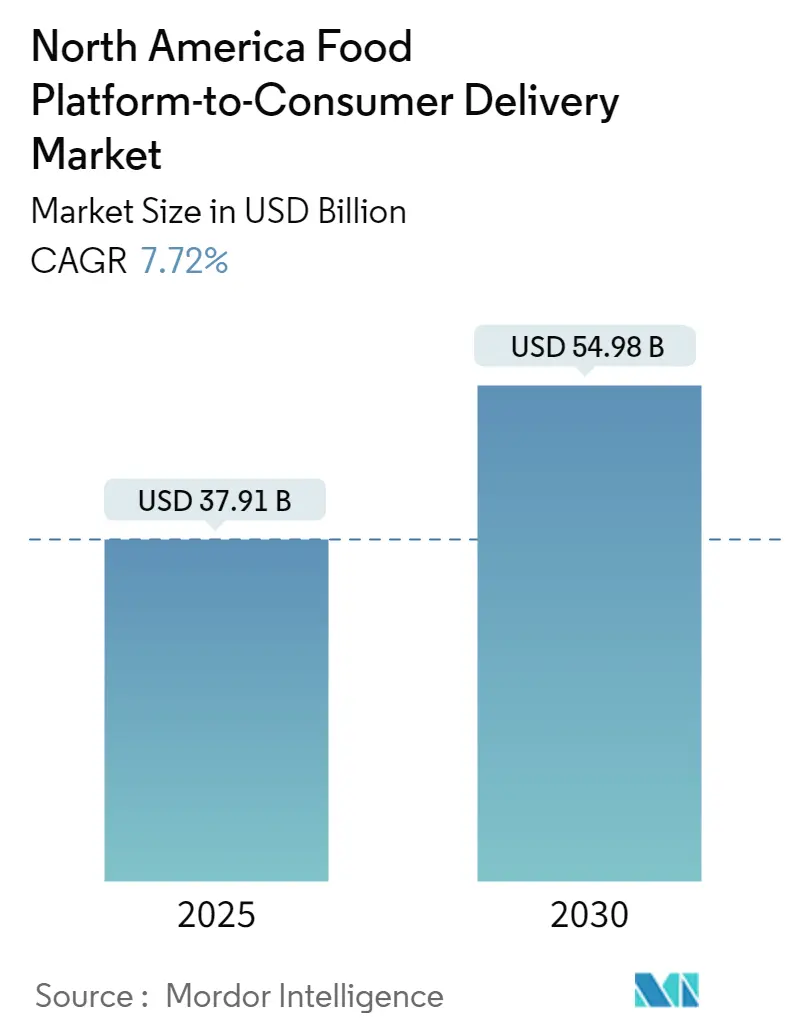
| Study Period | 2019 - 2030 |
| Base Year For Estimation | 2024 |
| Forecast Data Period | 2025 - 2030 |
| Market Size (2025) | USD 37.91 Billion |
| Market Size (2030) | USD 54.98 Billion |
| CAGR (2025 - 2030) | 7.72 % |
| Market Concentration | Medium |
Major Players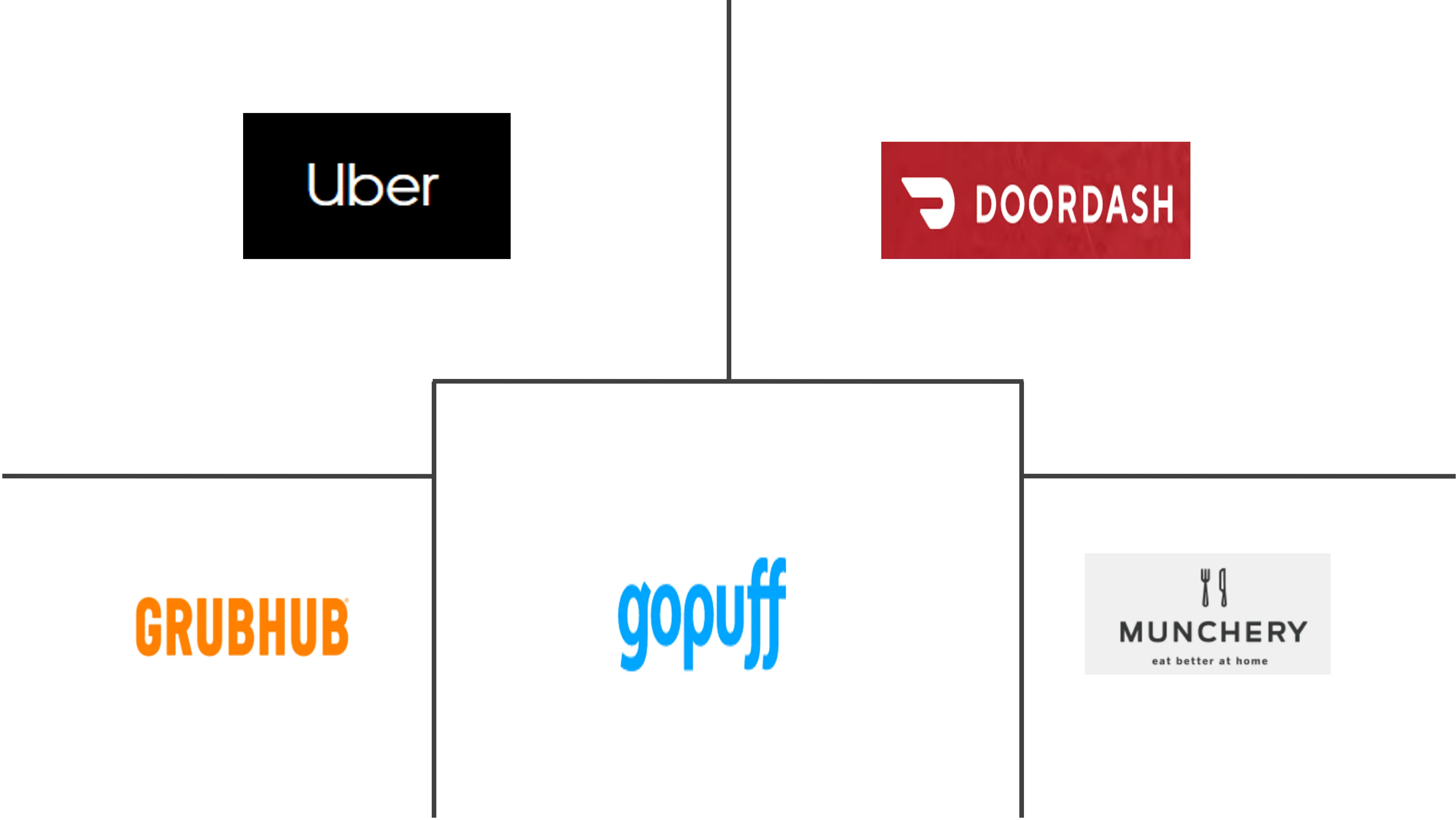
*Disclaimer: Major Players sorted in no particular order |
North America Food Platform-to-Consumer Delivery Market Analysis
The North America Food Platform-to-Consumer Delivery Market size is estimated at USD 37.91 billion in 2025, and is expected to reach USD 54.98 billion by 2030, at a CAGR of 7.72% during the forecast period (2025-2030).
The North American Food Platform-to-Consumer Delivery market is expected to grow at a higher rate, mainly due to strong user penetration rates in the United States. North America is one of the largest markets for international online food delivery; it currently represents the world's biggest online food delivery market. Several factors are now driving North America's online food platform-to-consumer delivery market. Significant urban population, busy lifestyles, and increasing penetration of the internet and smartphones are some of the key drivers that have driven the growth of online food delivery in the region.
- Moreover, the United States' large youthful population, which comprises most of the customer base, has further facilitated this growth. Various online food delivery service providers are experimenting with innovative food delivery methods via self-driving cars, drones, and robots, thereby positively influencing the market growth. Individuals' high living standards continue to spur the demand for online food delivery packaging services in the region.
- Online food-delivery platforms are expanding choice and convenience, allowing customers to order from a wide array of restaurants with a single tap of their mobile phone.
- During the COVID-19 pandemic, consumers increasingly use online services as their disposable income increases, electronic payments become more trustworthy, and the range of suppliers and the size of their delivery networks expand alongside the expansion of internet service.
- Although there are many impacts, which are not in favor of online food delivery services, in this worldwide pandemic, all around the world, the rise of online Food Delivery has changed the way that many consumers and food suppliers interact. This change's sustainability impacts (defined by the three pillars of economic, social, and environmental) have yet to be comprehensively assessed.
North America Food Platform-to-Consumer Delivery Market Trends
Rise of Mobile Penetration in North America
- The trend of online food ordering has been increasing in North America. One of the major driving factors would be the rising penetration of smartphones and internet connections in the region, which provide the opportunity to get food delivered very conveniently and quickly. Online food delivery offers consumers a wide range of food items on their smartphones and the convenience of getting them delivered at their doorsteps.
- Moreover, online food delivery companies provide numerous benefits to food service providers, one of the advantages of online food delivery is low labor requirements. Along with labor savings, other uses of online food delivery for foodservice providers include the increased convenience for the guest, accuracy of online orders, and simpler order processing.
- Online food ordering provides food service providers with key customer information and insights that can be useful for making promotional strategies, such as targeted promotions designed to create off-peak demand, specials targeted at particular customer segments, and couponing strategies.
- The rising penetration of the internet and the surging number of smartphone users represent the primary factors driving the market in North America. Besides this, the escalating demand for ready-to-eat (RTE) foods on account of the expanding working population is another major growth-inducing factor. Additionally, there has been widespread adoption of online food delivery services amid the recent coronavirus disease (COVID-19) outbreak due to stringent lockdown regulations and social distancing norms across the North American region. In line with this, owing to busy lifestyles, rapid urbanization, and lack of domestic help, the shifting inclination toward online food delivery, especially among the young population, has augmented the demand for online food delivery options.
- Furthermore, several key players are adopting innovative food delivery methods, including self-driving cars, drones, and robots, for enhanced convenience, safety, and cost-effectiveness. Along with this, recent technological advancements, such as integrating online food delivery platforms with the internet of things (IoT), artificial intelligence (AI), and predictive and big data analytics to offer a more personalized experience, have catalyzed the market growth. Other factors, including the rising popularity of cloud kitchens, elevating living standards, inflating consumer expenditure capacities, and availability of attractive discounts and offers on delivery platforms, are also a positive thrust to the market growth.
Surge in Use of Internet Across the Region
- Despite relaxed lockdown restrictions and many restaurants opening up for the dine-in experience, consumers have maintained the habit of placing orders through food delivery apps in 2021, with revenue projected to reach new heights in United States markets globally. Adjust's data reflects this, showing a consistent upward trend in growth for food and drink delivery apps, with no signs of slowing down. Global installs increased by 25% in 2020 compared to 2019 and are up by a further 21% in 2021. In the United States, the 2020 boost hit 30% and is up another 10% in 2021.
- The most successful food delivery apps offer customers a website that can be used in unison with their mobile app to ensure an optimal user experience. Users can log in via their desktop and in-app, enabling them to use your services in whichever way best suits them. For example, Uber Eats and JustEat both advertise their mobile apps with large panels on their landing page, with Just Eat suggesting that users download their app 'for faster ordering and more personalized recommendations.'
- Email marketing is a successful marketing method in the US that can help you connect with users. According to HubSpot, "more than 50 percent of US respondents check their email account more than ten times a day, and it is their preferred way to receive brand updates". Email marketing successfully reaches out to customers because users have to opt-in and actively show interest in receiving emails related to the brand app. Brands can use email marketing to reward users with promotional deals, building brand loyalty and incentivizing users to return to the company's app. Food Delivery brands can also send subscribers newsletter updates which is another way to share blog content and encourage users to follow them across their social media channels.
- Developing loyalty programs, offering coupons or digital stamp cards, or investing in gamification are a few additional methods that can be leveraged into successful user acquisition and retention strategies in the food delivery app vertical. The food delivery app vertical continues growing and evolving as markets take shape in a post-pandemic world. To thrive, apps must partner with the restaurants and vendors that best suit their users' needs and find clever ways to incentivize continued use in this more competitive-than-ever space.
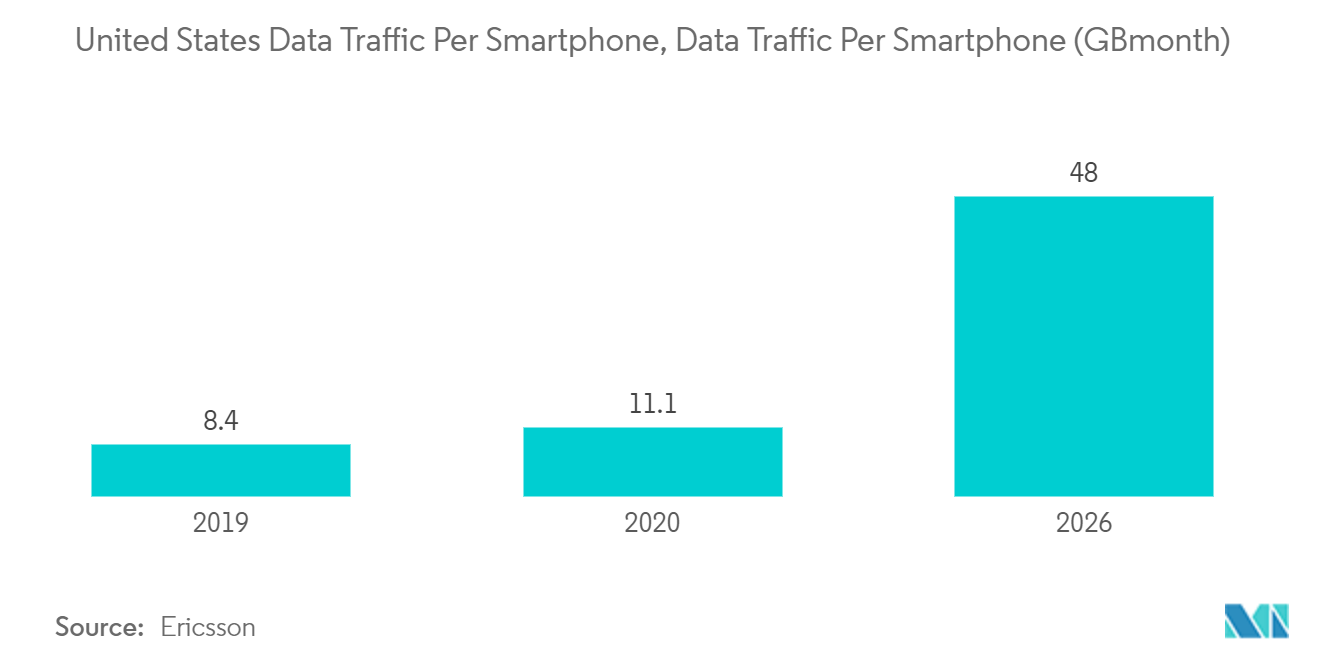
North America Food Platform-to-Consumer Delivery Industry Overview
North America Food Platform-to-Consumer Delivery Market has many competitors, with 10 to 14 prominent players. Some of the major players in North America, including Doordash, Uber Eats, Postmates, GrubHub -Seamless, and Caviar, are adopting strategies for developing the online food delivery market like new product development global expansion, acquisitions, and investments.
- July 2020 - Uber Technologies Inc acquired Postmates Inc for USD 2.65 billion to expand its food delivery market share and significantly increased the business of supplying everyday goods when the coronavirus has pummeled its core ride-hailing service. Uber said both companies' boards had approved the deal, which Uber expects to issue some 84 million shares of common stock. Uber offered a premium of about 10% on Postmates' last valuation of $2.4 billion. Its shares were up 5% at USD 32.24.
- February 2020 - the company was acquired by Just Eat Takeaway, a food delivery platform based in the Netherlands. Grubhub is one of the leading online and mobile food-ordering and delivery platforms based in America, which Just Eat Takeaway owns. In 2020, the company was acquired by JustEat Takeaway, a food delivery platform based in the Netherlands.
- February 2020 - JustEat the companies merged into Just Eat Takeaway.com, Just Eat's parent company. In 2020, Just Eat partnered with fast-food giant McDonald's to deliver food in the United States. Just Eat functions in over ten countries across Europe, North America, Latin America, Israel, and Australasia.
North America Food Platform-to-Consumer Delivery Market Leaders
-
DoorDash, Inc.
-
Uber Technologies Inc. (UberEats)
-
Grubhub Inc.
-
Seamless North America LLC
-
goBrands, Inc. (goPuff Delivery)
- *Disclaimer: Major Players sorted in no particular order
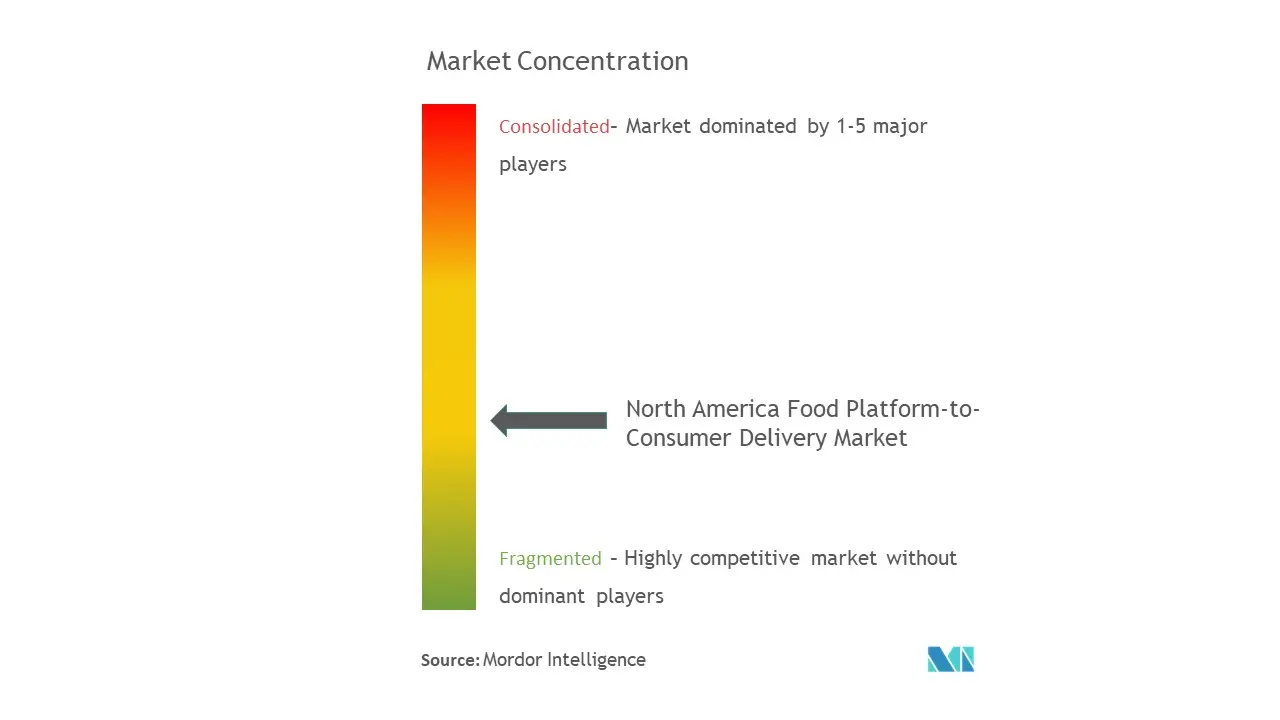
North America Food Platform-to-Consumer Delivery Market News
- November 2021 - DoorDash Inc., DoorDash Inc said it's buying Finnish food-delivery startup Wolt Enterprises Oy for about USD 8 billion. The biggest meal-delivery service in the U.S. said it's buying Finnish food-delivery startup Wolt Enterprises Oy for about $8 billion as it seeks to stay ahead of rivals in the race to satisfy soaring demand for the fast delivery of everything from food to prescriptions and pet supplies.
- June 2021 - Uber has been pushing itself beyond ride-hailing and has seen strength in its Uber Eats business due to the Covid-19 pandemic.
North America Food Platform-to-Consumer Delivery Industry Segmentation
Food Platform-to-Consumer Delivery market cover revenues of an online business that acts as an intermediary between consumers and multiple food facilities to submit food orders from a consumer to a participating food facility and to arrange for the delivery of the order from the food facility to the consumer. A food platform to consumer delivery model is a business model where the customers can get their favorite food by making an order via their smartphones.
The North America food platform-to-consumer delivery market is segmented by country (United States, Canada). The market sizes and forecasts are provided in terms of value (USD) for all the above segments.
| By Country | United States |
| Canada |
North America Food Platform-to-Consumer Delivery Market Research FAQs
How big is the North America Food Platform-to-Consumer Delivery Market?
The North America Food Platform-to-Consumer Delivery Market size is expected to reach USD 37.91 billion in 2025 and grow at a CAGR of 7.72% to reach USD 54.98 billion by 2030.
What is the current North America Food Platform-to-Consumer Delivery Market size?
In 2025, the North America Food Platform-to-Consumer Delivery Market size is expected to reach USD 37.91 billion.
Who are the key players in North America Food Platform-to-Consumer Delivery Market?
DoorDash, Inc., Uber Technologies Inc. (UberEats), Grubhub Inc., Seamless North America LLC and goBrands, Inc. (goPuff Delivery) are the major companies operating in the North America Food Platform-to-Consumer Delivery Market.
What years does this North America Food Platform-to-Consumer Delivery Market cover, and what was the market size in 2024?
In 2024, the North America Food Platform-to-Consumer Delivery Market size was estimated at USD 34.98 billion. The report covers the North America Food Platform-to-Consumer Delivery Market historical market size for years: 2019, 2020, 2021, 2022, 2023 and 2024. The report also forecasts the North America Food Platform-to-Consumer Delivery Market size for years: 2025, 2026, 2027, 2028, 2029 and 2030.
Our Best Selling Reports
North America Food Delivery Platform Industry Report
Statistics for the 2025 North America Food Platform-to-Consumer Delivery market share, size and revenue growth rate, created by Mordor Intelligence™ Industry Reports. North America Food Platform-to-Consumer Delivery analysis includes a market forecast outlook for 2025 to 2030 and historical overview. Get a sample of this industry analysis as a free report PDF download.



